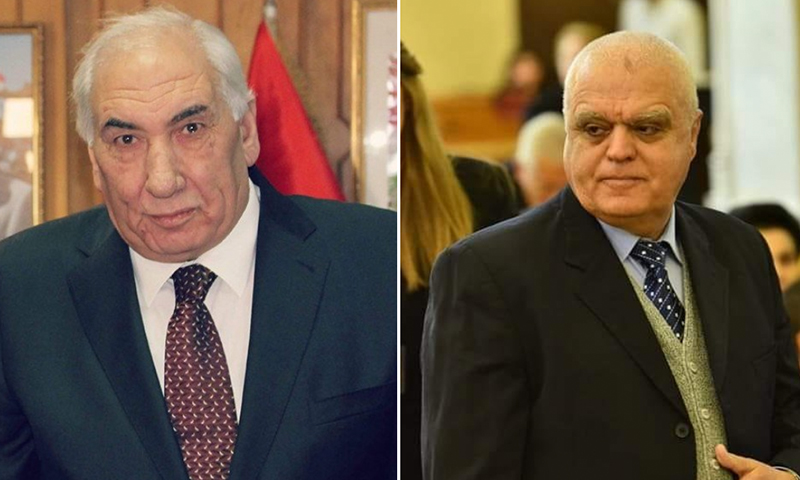



Enab Baladi – Murad Abdul Jalil
The Syrian officials in Syria’s southern province of Daraa were not routinely appointed over the past years, but driven by changing contexts, map of power and control of the conflicting parties, and the problematic issues in the province.
Daraa has gone through several stages since 2011. Widespread protests against the Syrian regime took place, all of which were handled with the security branches’ mindset.
Then, the peaceful demonstrations turned into an armed conflict between the “Free Syrian Army (FSA)”, and other armed opposition factions against the Syrian regime forces backed by Iranian militias and Russian air force. Then, a “settlement” agreement was reached in 2018 under Russian supervision.
In early April 2011, nearly two weeks after the outbreak of the Syrian revolution, the head of the Syrian regime, Bashar al-Assad, issued a decree appointing Muhammad Khalid al-Hanus, the governor of Daraa, to succeed Faisal Kalthoum, who had been sacked along with several security leaders.
The appointment of al-Hanus, who is originally from Hama countryside and was a major general, came at a crucial juncture in the province, due to the popular rage against those involved in the killing of children. The demonstrators demanded to hold them accountable, especially the political security chief in Daraa, Atef Najeeb, a cousin of al-Assad.
Al-Hanus was appointed in the first place to calm the inflamed spirits of Syrian protesters at that time, as al-Hanus spent most of his military service in Daraa, and he had extensive connections with the people and dignitaries of the province. However, with the security mentality employed by the Syrian regime, al-Hanus changed nothing for the better.
Al-Hanus remained in his position, without showing up throughout the evolving political and security landscape in the province; the opposition factions expanded their control over the province. But, al-Hanus appeared during the “settlement” agreement in 2018, to begin his movements and release media statements about improving the service sector by holding meetings with the people and carrying out civic activities.
Following “the settlement agreement,” the situation in Daraa reached the crisis, Daraa has been going through the adverse living and economic conditions. The Syrian regime’s government failed to provide its citizens with the simplist necessary materials and services such as the provision of fuel and electricity. The Horan Free League reported that some people met with the governor of the province several times. However, the governor refused to comply with their demands saying, “Go out of Syria if you do not like the situation here.” The sentence of the governor, early 2019, manifests the mentality which the Syrian regime uses when dealing with the demands of people.
Insecurity is growing rampant in Daraa, represented by the escalating assassinations, kidnappings, and the Syrian regime’s failure to abide by the “settlement agreement.” All these resulted in the return of the protests in some areas.
And all of a sudden, al-Assad issued a decree on 30 May, stipulating the appointment of Major General Marwan Ibrahim Sharbak, who hails from al-Muzayraa village in Latakia governorate, as governor, succeeding al-Hanus.
Sharbak was previously commander of the Signal Corps and a senior officer of the Republican Guard before he retired after 43-year military service.
Sharbak has been appointed at a critical period in Daraa governorate, especially in the western countryside; the Syrian regime is trying to tighten its grip and expand its control over the region and, as it is ruled by the “settlement” agreement under Russian supervision, and weapons are still in the hands of the previous opposition factions.
Furthermore, Sharbak’s appointment took place following the agreement between the Syrian regime and the Central Committee—the CC was established after the Syrian regime’s entry into the southern region, consists of civilian figures and leaders in the “Free Syrian Army”,and its task is to negotiate and represent the people as well as transfer their demands to the regime and the Russians—to strengthen the military checkpoints occupied by the Fourth Armored Division in the western countryside.
After that, prominent members in the CC, including Adnan al-Shambour, Raafat al-Barazi, and Uday al-Hasheesh, were assassinated with an ambush between the towns of al-Ajami and Mazirib as well as two other leaders were wounded.
After that, the Fourth Armored Division begin to deploy in several areas that were not within the agreement.
All these security, social and economic developments have prompted the Syrian regime to change, and keep pace with the developments of the current scene, awaiting the events of the coming weeks that may be titled “security grip” for imposing and establishing the regime’s influence in the governorate.
if you think the article contain wrong information or you have additional details Send Correction